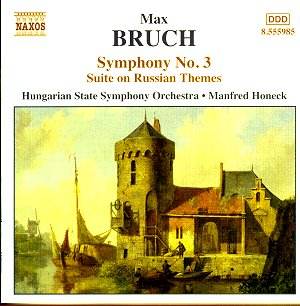|
|
Search MusicWeb Here |
|
 |
||
|
Founder:
Len Mullenger (1942-2025) Editor
in Chief:John Quinn
|
|
|
Search MusicWeb Here |
|
 |
||
|
Founder:
Len Mullenger (1942-2025) Editor
in Chief:John Quinn
|
 |
Max BRUCH (1838-1920) |
|
AmazonUK AmazonUS |
|
Recorded in May 1987 and first released on Marco Polo 8.223104 this budget price Naxos re-issue restores Bruch’s amiable Third Symphony to the catalogue in Honeck’s generally successful performance. Composed in Liverpool but using material from many years earlier the work was commissioned by the New York Symphony Society under conductor and scion of the musical family, Leopold Damrosch. It was first performed in 1883 under Georg Henschel in Boston and subsequently revised – German performances under Joachim and Von Bülow followed but, as with the cool reception accorded to his Second Symphony, the work made very little headway. Clearly a nostalgic work, it is motivically related to the overture to the opera Lorely – is this ever going to be recorded? – and to the verdant and bustling Rhineland writing of Bruch’s young manhood. The opening movement of the work embraces a second subject that reminds one of Ernest Newman’s comment about "one of Max Bruch’s pussycats", apropos Menuhin’s luscious playing of Elgar’s Violin Concerto. But purring pussycat or otherwise this is a beautiful moment, orchestrated with mastery and spun into a melody of elasticity and effulgent lyricism. The following Allegro molto vivace section of the movement is a vigorous working out, gruff and determined in mood, inclining sometimes almost to the indomitable but capable also of relaxing into oases of reflectiveness and rumination. The slow movement may or may not allude to Schumann’s Fourth Symphony, which again might hint at some other internal textual references; despite this the movement doesn’t wear its heart on its sleeve. The scherzo is lively, orchestrally rich, a dance movement of pleasurable simplicity – rhythmically vivacious, energetic, with expertly crafted transient episodes of careful diminuendo. The Finale by contrast opens with a kind of moderato lyricism, flecked and lightened by a delicious little melody before burgeoning into lively developmental writing. This is a structurally cohesive Symphony, nostalgic in cast, rather conventional in structure, pleasurable to hear. |
|
Return to Index |